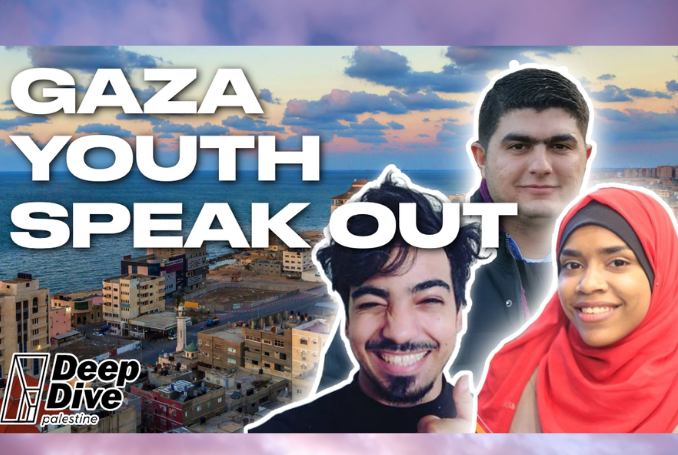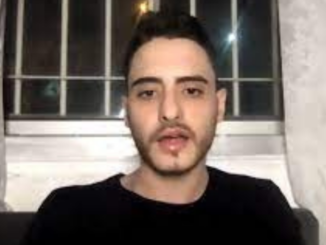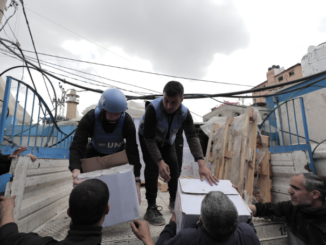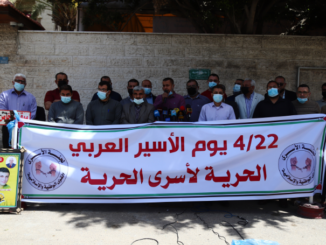
Palestine Deep Dive’s latest live show, ‘One Year On: Under Fire, Under Siege – Gaza Youth Speak Out!’, gives a platform to young Palestinians a year on from Israel’s deadly assaults on Gaza in May 2021.
PDD’s show host, Mark Seddon, catches up with Palestinian writer and activist, Raed Shakshak and medical doctor and child mental health specialist, Dr. Bahzad Alakhras, who both featured on last year’s show.
Also joining them this time is writer and translator, Samah Atef, one of We Are Not Numbers’ new members.
Mark, who was Al Jazeera’s first UN correspondent, starts the episode with a video clip of Raed speaking to him live last year during the escalation, and showing what subsequently happened later that evening, on May 19, 2021.
While live on Instagram with British-Iraqi musician, Lowkey, and American Muslims for Palestine Digital Media Associate, Zarefah Baroud, an explosion erupts in Raed’s vicinity.
“Oh my God. That was really strong. It was really loud. Oh my God. It’s really close. There’s no power here. My God, my phone is 1%, and it’s going to lose connection now,” Raed is heard saying shortly before his phone battery dies, unable to recharge it due to widespread power shortages caused by the Israeli blockade.
The Israeli bombardment of Gaza in May 2021 killed 256 Palestinians in 11 days, including 66 children, while 13 Israelis were also killed in the escalation.
Shireen Abu Akleh and the Wider Media
Turning to the recent murder of Palestinian journalist, Shireen Abu Akleh, Mark asks Raed and Samah what their reactions were to the news.
Raed: “Ever since we were kids, all of us here in Palestine, we used to watch the TV, and we used to watch Shireen. All of us have heard it like so many times, ‘Abu Akleh, Al Jazeera, Palestine,’ and so we got super emotional.”
“You know what they say, a pen is mightier than a sword, and Shireen’s pen, and when I say pen, as a journalist, she wrote, she captured photos, she recorded videos. She spoke to the people, and therefore, she exposed the history of Israeli occupations. She exposed the massacres, the crimes.”
Samah: “Actually it was very shocking for me. I was raised listening to Shireen. I knew a lot about Palestine listening to her and watching her on TV. It was my dream to become a journalist, to be like Shireen… I wanted the whole world to know about Shireen by publishing about her, by talking about her, and by knowing the crimes that the Israeli army is doing against us in Gaza and in the whole of Palestine. She did nothing wrong. She was just exposing them. She was wearing the press vest, which apparently should save every journalist, but she was cold-bloodedly killed.”
Raed: “I just want to say what’s been going on here in Palestine the past few days basically shows you the real face of the occupation. I said it before. I will say it again. Now, the whole world is reacting to that, they have this outrageous reaction, but at the same time, there is no action.”
“Shireen is famous. Everyone knows her. She’s got some really great publicity, but at the same time, there are so many Palestinians who are not as famous as Shireen who get attacked on a daily basis, who get arrested, who get shot.”
Gaza’s Mental Health Crisis
Discussing the ongoing mental health crisis in Gaza, Samah reflects on her own experience being raised under siege:
“I’ve lived in Gaza my whole life, I’ve never left Gaza before. It’s really abnormal. We have never seen anywhere outside the siege. The things that other people have on a daily basis, are luxuries for us. For example, some people might travel and vacation, we cannot do that.”
Gaza has been under a hermetic blockade by land, air and sea since 2006, making it almost impossible for Palestinians to leave the enclave.
The 141 square-mile strip of land, one of the world’s most densely populated places, is home to two million Palestinians, one million of them children.
“Can you imagine that some streets are still destroyed from the last year?” Samah continues.
“The house right in front of me was destroyed the last year, and until today, when I opened my window, and I look, there’s nothing. There’s just a very empty place that reminds me of my neighbors that they used to live here. It’s really reminding us every day that we are not living the life we deserve to live.”
Responding to Mark’s question on what happened on the night of the attack, Samah says,
“It’s a very civilian area. We are all civilians living around each other. At 3:00 AM, they [Israeli intelligence] just made a call saying, ‘Free the area, we want to bomb it,’ and lots of people died in the process. We were leaving our houses, 3:00 AM, knowing nothing but that we have to leave. We have to flee for our lives, and it really breaks my heart, like, what did we do? We did nothing. We were living simply, and all of a sudden, everything was bombed around us.”
Only 200 out of 1,700 destroyed buildings have been rebuilt in Gaza, according to the Ministry of Public Works. Over 22,000 buildings were damaged according to the United Nations.
Dr. Bahzad goes on to expose the mental health crisis among Gaza’s population:
“Humans live between two modes; the survival mode and the learning mode. The learning mode is when you are comfortable, when you are relaxed… The survival mode is when you are brought into real danger. Continuous exposure to trauma makes the usual mode as the survival mode, which is the emergency mode for the human being.
“Unfortunately, with most people here in Gaza, people are– as I said, in my opinion, they are not really living, they are surviving. There is a difference between surviving and living, enjoying your life.”
Even before the bombardment in May 2021, Save the Children report 95% of children in Gaza experienced symptoms of deep psychological distress, including feelings of depression, hyperactivity, aggression, and a preference for being alone.
“You see people in the streets, in work, in schools, but when you ask them, for example, about their future plans, most people would not give you a concrete plan for the future. Why? Because they are living in the survival mode, which is trying to move them from the danger right now.
“This is as a result of the continuous exposure to trauma. We hear that there is no ‘P’ in the PTSD here in Gaza, there is no Post-Traumatic Stress Disorder. What people in Gaza [have] is what we can call ‘Continuous Traumatic Stress Disorder.’ There is no endpoint to the trauma… I’m always saying this, but if you’re treating the victim, for example, after the war in 2008-2009, then there was that escalation, 2012, then in 2014, now with last year. With time, it makes it complicated and difficult to treat.”
According to the UN, 2,251 Palestinians were killed in seven weeks in Gaza in the summer of 2014, including 551 children.
“During acute escalations or offenses against Gaza, we face what we call the direct or acute danger or death. Between escalations, unfortunately, we go back to the slow death. As my colleagues mentioned, closure of borders, difficulty on travel, shortage of electricity, all means of life are threatened. We are moving between a slow and rapid death.”
Dreams and Ambitions
Asked what can be done to ease the situation on Gaza, Bahzad responds:
“By opening the borders, by providing complete financial and logistical [support to] the government here, by easing travel means, putting an end to these continuous offenses against the Gazan people, by not believing their [Israel’s} narrative. I think now it’s easier than any time before to see the authentic narrative.”
Towards the close of the show, Mark puts an audience question to each of the panellists, “What are your aims and ambitions?”
“That’s a difficult question because I think all of us have personal dreams, but unfortunately since we came to this life as Palestinians, our personal dreams are always hurting, but a holistic dream, I would say that I wish me, my friends, my family would live a better life, a peaceful life, like just I saw and experienced in London in the UK,” Bahzad said.
“I have so many dreams actually, but I really wish to go to Jerusalem. My dream is to have the borders erased and be able to go Saturday to Jerusalem, Sunday to Jenin, which are cities in my own country that I’ve never been to and I cannot go to. I really dream to have electricity 24/7 which is a simple thing, but I really wish to have it,” Samah added.
“I really want to go finish my education outside Gaza. I really want to see the world. I want to know what is the meaning of freedom. I want to smell it in the air and I want to go to work, not feeling afraid that I might go home and find someone missing from my family.”
“Yes. My basic dream is to be free… I want to go to Palestine and see the entire Palestine. I hear a lot of people who get to be there. Most of them are not Palestinians. For me, as a Palestinian who’s incapable of going there, it hurts me. Also, I wish to travel. I’m someone who’s passionate about traveling, but at the same time, I know that once I cross the border after six or seven months of registration and waiting for my turn to travel, it would be so hard for me to come back to Gaza for a visit,” Raed said.
(Palestine Deep Dive)







